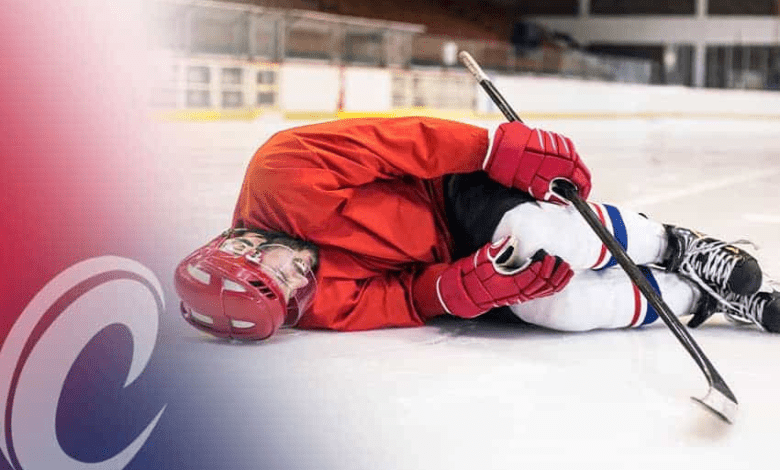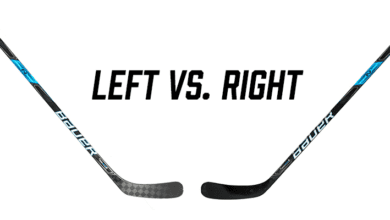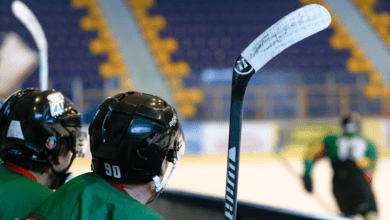How to Prevent Hockey Injuries

How to Prevent Hockey Injuries, Ice hockey is an exhilarating and physically demanding sport that requires skill, agility, and strength. However, it also carries a risk of injuries due to the high-speed nature of the game and physical contact involved. Fortunately, there are steps players can take to minimize the risk of injuries and stay safe on the ice. In this article, we will discuss important strategies and tips to prevent hockey injuries.
How to Prevent Hockey Injuries
Hockey injuries can range from minor bruises and strains to more severe injuries like concussions and fractures. By implementing preventive measures and practicing good safety habits, players can significantly reduce their chances of getting injured and enjoy the game with peace of mind.
1. Warm-Up and Stretch
Before hitting the ice, it’s crucial to warm up properly and stretch your muscles. Engaging in dynamic warm-up exercises, such as jogging or jumping jacks, helps increase blood flow to the muscles and prepares them for the physical demands of hockey. Additionally, perform stretching exercises targeting major muscle groups to improve flexibility and reduce the risk of strains and muscle pulls.
2. Wear Protective Gear
One of the most effective ways to prevent hockey injuries is by wearing proper protective gear. This includes a well-fitting helmet with a certified face mask, shoulder pads, elbow pads, shin guards, gloves, and a mouthguard. Ensure that all equipment is in good condition and replace any damaged or worn-out gear promptly. Protective gear serves as a crucial barrier against direct impacts and reduces the risk of head, face, and body injuries.
3. Learn Proper Technique
Mastering the correct hockey techniques and skills is essential for injury prevention. Enroll in structured training programs or work with experienced coaches who can teach you proper skating, shooting, checking, and defensive techniques. Learning the right form and body mechanics not only improves performance but also reduces the likelihood of accidents and injuries caused by poor technique.
4. Strengthen and Condition
Building strength and conditioning is vital for injury prevention in hockey. Incorporate off-ice exercises that target muscle groups used in hockey, such as the legs, core, and upper body. Focus on exercises that enhance balance, stability, and explosive power. Regular strength training sessions improve overall body strength and endurance, enabling players to withstand physical challenges and reduce the risk of injuries.
5. Practice Good Sportsmanship
Practicing good sportsmanship is a fundamental aspect of any sport, including hockey. It refers to displaying respect, integrity, and fair play towards opponents, teammates, coaches, officials, and the game itself. Good sportsmanship goes beyond winning or losing and encompasses values such as honesty, humility, and respect for the rules and spirit of the game.
In the context of hockey, practicing good sportsmanship involves several key principles:
- Respecting opponents: Players should treat their opponents with respect both on and off the ice. This means avoiding actions that could intentionally harm or endanger opponents, such as using excessive force during collisions or engaging in unsportsmanlike behavior. Respect for opponents fosters a competitive yet safe and fair playing environment.
- Abiding by the rules: Good sportsmanship entails following the rules of the game and accepting the decisions made by officials. Players should refrain from engaging in behaviors that violate the rules or seeking to gain an unfair advantage through cheating or unsportsmanlike conduct. Respecting the rules ensures a level playing field for all participants and upholds the integrity of the game.
- Showing appreciation for good play: Acknowledging and appreciating the skills and efforts of both teammates and opponents is an important aspect of good sportsmanship. Congratulating opponents on their achievements, complimenting good plays, and showing support for teammates contribute to a positive and sportsmanlike atmosphere.
- Accepting outcomes gracefully: Accepting victory and defeat with grace is a crucial part of good sportsmanship. Whether winning or losing, players should display humility and respect towards their opponents. Celebrating victories without taunting or belittling the opposing team and showing grace in defeat by congratulating the winning team exemplify good sportsmanship.
- Supporting teammates: Good sportsmanship extends to how players treat their own teammates. Encouraging and supporting teammates, even in challenging moments, helps foster camaraderie and a positive team environment. Respectful communication, cooperation, and unity among teammates contribute to a healthy and enjoyable hockey experience.
Practicing good sportsmanship in hockey is not only important for creating a positive playing environment but also for personal growth and character development. It teaches valuable life lessons such as integrity, resilience, and empathy. Moreover, it enhances the overall enjoyment and spirit of the game for all participants.
By embodying the principles of good sportsmanship, players contribute to a culture of respect, fairness, and camaraderie within the hockey community. They serve as role models for younger players and contribute to a safer, more inclusive, and fulfilling hockey experience for everyone involved.
6. Stay Hydrated
Staying hydrated is crucial for maintaining optimal health and preventing various health issues, including those related to physical activity such as sports. When it comes to sports like hockey, proper hydration is even more important due to the intense physical demands and the potential for fluid loss through sweating.
During physical exertion, the body sweats to regulate its temperature. As sweat evaporates from the skin, it helps cool the body down. However, this process also leads to fluid loss. If the lost fluids are not adequately replenished, it can result in dehydration.
Dehydration occurs when the body loses more fluids than it takes in, leading to an imbalance in the body’s water content. Even mild dehydration can have detrimental effects on athletic performance and overall well-being. Here’s why staying hydrated is crucial for hockey players:
- Maintains Fluid Balance: Proper hydration helps maintain the body’s fluid balance, which is essential for optimal functioning. It ensures that bodily systems, such as circulation, digestion, and temperature regulation, can operate efficiently.
- Optimizes Performance: Dehydration can negatively impact athletic performance. It can lead to decreased endurance, impaired focus, reduced strength, and slower reaction times. By staying hydrated, hockey players can perform at their best and maintain their energy levels throughout the game.
- Regulates Body Temperature: Hockey is a physically demanding sport that can raise body temperature significantly. Sweating is the body’s natural cooling mechanism, but without sufficient hydration, the cooling process is less effective. Proper hydration helps regulate body temperature and prevents overheating during intense physical activity.
- Prevents Muscle Cramps: Dehydration increases the risk of muscle cramps, which can be painful and hinder performance. When the body lacks adequate fluids, electrolyte imbalances can occur, affecting muscle function. By staying hydrated, athletes can reduce the likelihood of muscle cramps and maintain optimal muscle performance.
- Enhances Recovery: Hydration plays a vital role in the recovery process after intense exercise or competition. It helps facilitate the delivery of nutrients to muscles, aids in the removal of waste products, and supports tissue repair. Proper hydration promotes faster recovery and reduces the risk of post-exercise fatigue and soreness.
To stay hydrated while playing hockey or engaging in any physical activity, here are some essential tips:
- Drink Plenty of Water: Regularly consume water before, during, and after the game or practice session. Aim to drink fluids even before you feel thirsty, as thirst is not always an accurate indicator of hydration status.
- Avoid Excessive Sugary or Caffeinated Drinks: While small amounts of sports drinks may be beneficial for replenishing electrolytes during intense exercise, excessive consumption of sugary or caffeinated drinks can contribute to dehydration. Stick to water as the primary source of hydration.
- Monitor Urine Color: Monitoring the color of your urine can provide a rough indicator of your hydration status. Pale yellow urine usually indicates proper hydration, while dark-colored urine suggests dehydration.
- Plan Ahead: Ensure you are adequately hydrated in the hours leading up to a game or practice session. Hydration is an ongoing process, so make it a habit to drink fluids consistently throughout the day, especially during periods of intense training or competition.
7. Rest and Recover
Rest and recovery are crucial aspects of injury prevention and overall athletic performance. In the context of preventing hockey injuries, rest and recovery refer to taking appropriate breaks and allowing the body time to heal and regenerate after intense physical activity.
Rest involves taking scheduled days off from training and games. It allows the body to recover from the stress and strain placed on it during hockey activities. Rest days provide an opportunity for muscles, joints, and connective tissues to repair and rebuild, reducing the risk of overuse injuries and fatigue. Adequate rest also helps restore energy levels and mental focus, promoting optimal performance during subsequent training sessions and games.

Recovery, on the other hand, involves implementing strategies and practices that facilitate the healing process and enhance overall recovery. This can include activities such as:
- Sleep: Getting sufficient and quality sleep is essential for recovery. During sleep, the body repairs damaged tissues, regulates hormone levels, and consolidates learning and memory. Aim for 7-9 hours of uninterrupted sleep each night.
- Nutrition: Consuming a well-balanced diet that includes adequate protein, carbohydrates, healthy fats, and micronutrients supports recovery. Proper nutrition provides the necessary building blocks for tissue repair and replenishes energy stores.
- Hydration: Staying hydrated is crucial for overall health and recovery. It helps maintain optimal bodily functions, supports nutrient delivery to cells, and aids in the removal of waste products. Drink water regularly and replace fluids lost through sweating during hockey activities.
- Active Recovery: Engaging in low-intensity activities such as light aerobic exercise, stretching, or foam rolling can enhance blood flow, reduce muscle soreness, and promote recovery. Active recovery can also help flush out metabolic waste products and improve joint mobility.
- Recovery Modalities: Utilizing recovery modalities such as ice baths, compression garments, or massage therapy can aid in reducing inflammation, alleviating muscle soreness, and promoting recovery. These modalities can be particularly beneficial after intense training sessions or games.
By incorporating rest and recovery into your training routine, you allow your body the time and resources it needs to repair and adapt to the physical demands of hockey. This helps minimize the risk of overuse injuries, improves performance, and enhances long-term athletic development. Remember, rest and recovery are essential components of a well-rounded training program and should be prioritized alongside skill development and conditioning.
More Posts
How to Place Successful Football Bets
How to Draft a Winning Fantasy Football Team
How to Stay Updated with IPL News and Player Performances
How to Improve Your Football Skills
Conclusion
Preventing hockey injuries requires a combination of proactive measures, proper equipment, skill development, and a focus on safety. By following these strategies, players can minimize the risk of injuries and continue to enjoy the game they love. Remember, injury prevention is a collective effort that involves players, coaches, and officials working together to create a safe and enjoyable hockey environment.
FAQs
Q: Are mouthguards necessary in hockey?
A: Yes, wearing a mouthguard is highly recommended in hockey. It helps protect the teeth, jaw, and mouth from impacts and can reduce the severity of injuries during collisions or falls.
Q: Should players warm up before every game and practice?
A: Yes, warming up before every game and practice is essential. It prepares the body for physical exertion, increases blood flow to the muscles, and reduces the risk of muscle strains and injuries.
Q: How can I improve my balance and stability for hockey?
A: Incorporate exercises like single-leg squats, balance board exercises, and stability ball exercises into your training routine. These exercises help improve balance, stability, and proprioception, reducing the risk of falls and injuries.
Q: What should I do if I get injured during a game?
A: If you sustain an injury during a game, it’s important to assess the severity. Seek immediate medical attention for any severe injuries or if you suspect a concussion. For minor injuries, follow the RICE protocol (Rest, Ice, Compression, Elevation) and consult with a healthcare professional for further guidance.
Q: Are there any specific exercises to prevent groin injuries in hockey?
A: Yes, performing exercises that target the groin muscles, such as adductor stretches and strengthening exercises, can help prevent groin injuries. Consult with a trainer or physical therapist for specific exercises tailored to your needs.
Remember, injury prevention is a continuous effort that requires a proactive approach, proper technique, and adherence to safety guidelines. By implementing these strategies, players can reduce the risk of hockey injuries and enjoy the game to its fullest.




